8 Most Common Types of Butterflies in Maryland
-
Pete Ortiz
- Last updated:
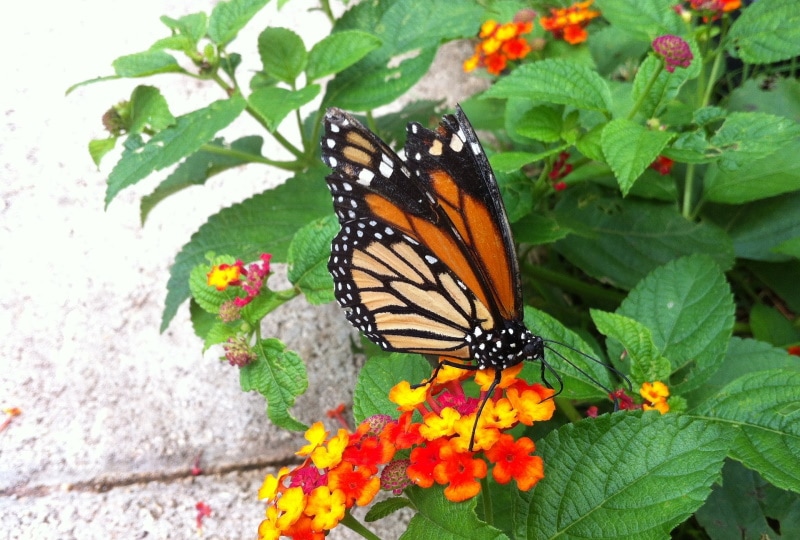
In Maryland, spring and summer meadows and gardens are graced with delicate butterflies flitting between the flowers and trees. The state has roughly 150 butterfly species, with a few varieties native to Maryland. While many of these species are classified as endangered, others are pretty common, especially during peak blooming season.
Below is a reference guide of eight of Maryland’s most common butterfly species. They range from large, brightly colored species that are quick to spot to small drab ones that people easily overlook.
We will discuss the key identification indicators, peak season, habitat, and preferred food of these visually captivating creatures.
The 8 Most Common Butterflies in Maryland
1. Zebra Swallowtail
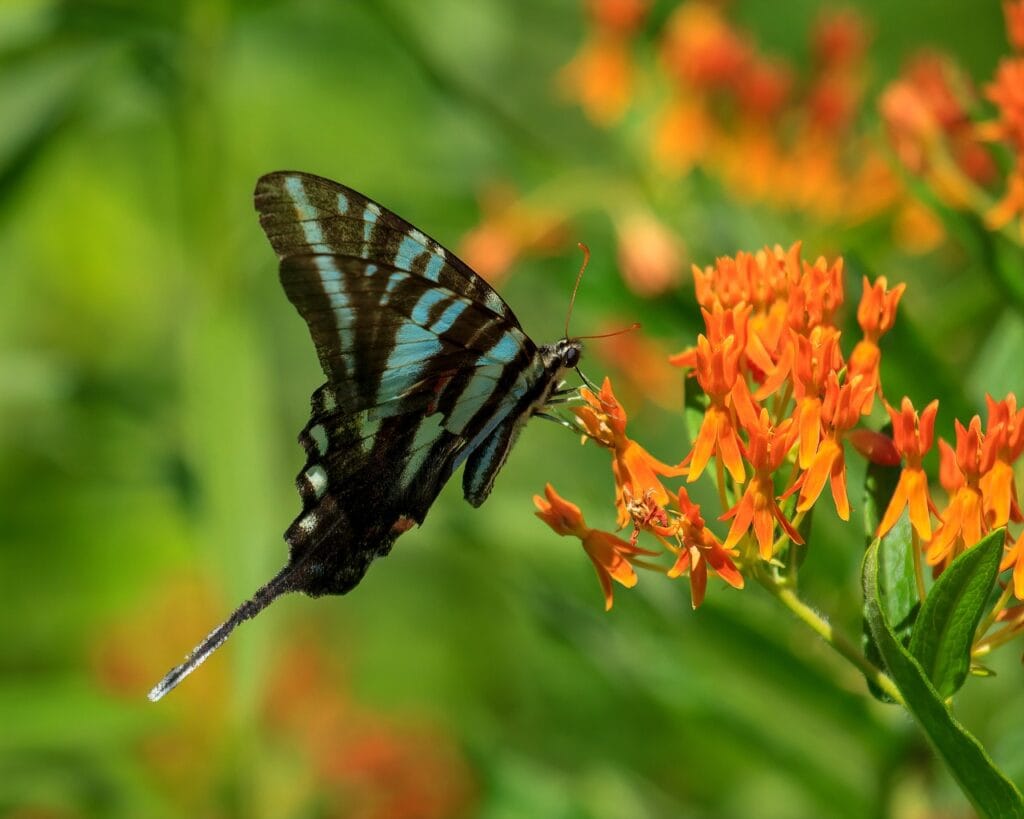
| Scientific Name: | Protographium marcellus |
| Wingspan: | 2.5 to 4.0 inches |
| Peak Season: | Spring and summer |
| Adult Lifespan: | 6 to 14 days |
The zebra swallowtails are distinct for their wing patterns resembling zebra stripes. You’ll also notice red spots on the wings towards the end of the lower part of the body and red-colored antennae.
There are slight differences in the markings of the butterflies, depending on whether you sight spring or summer broods. Generally, spring broods are smaller, with a lighter hue, while summer broods are easier to spot hovering across fields and gardens. They are larger with a deep, more apparent shade.
Preferred Habitat
The zebra swallowtail is a common sight in many landscapes across Maryland. However, the butterfly species is particularly fond of moist wood habitats. In landscapes offering nectar plants like Sweet William, milkweed, and cosmos or host plants like pawpaw, you can find zebra swallowtails in higher populations.
2. Monarch
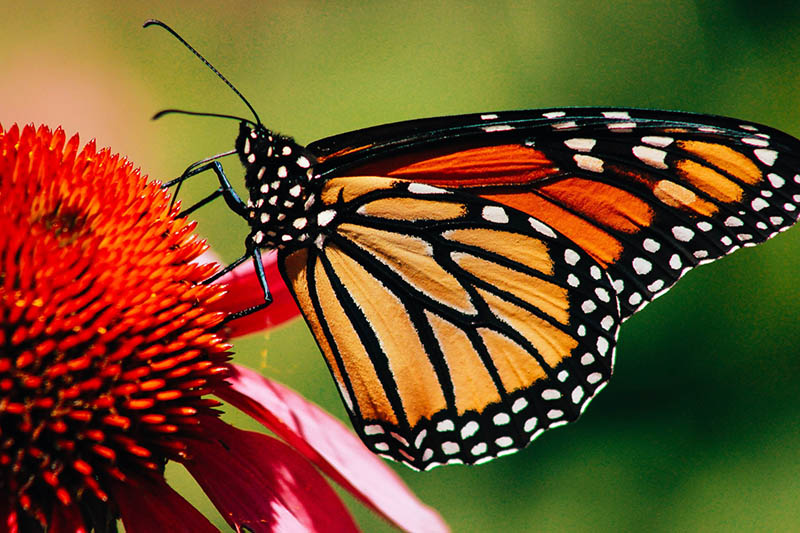
| Scientific Name: | Danaus plexippus |
| Wingspan: | 3.5 to 4 inches |
| Peak Season: | Summer |
| Adult Lifespan: | 4 to 5 weeks |
Monarchs are among the most easily recognizable butterfly species for their stained glass aesthetics. They have orange wings with black veins and two rows of white dots aligned along the black-colored edges.
Even with the dwindling population of the butterfly species, they are still the most common in Maryland.
The monarch butterfly represents nature at its most powerful. While the creature is relatively small and delicate, it boasts one of the most evolved annual generational migration patterns known to insects. The butterflies fly up to 4,000 feet high at an average speed of 12 miles per hour. They migrate from southern Canada and the Northern US to their hibernating destination in Mexico.
Preferred Habitat
You can expect to see monarchs in Maryland on any landscape with milkweed. Caterpillars feed primarily on poison from milkweed to keep predators away. You can find these butterflies in meadows, prairies, and grasslands that are perfect summer breeding grounds.
3. Cabbage White
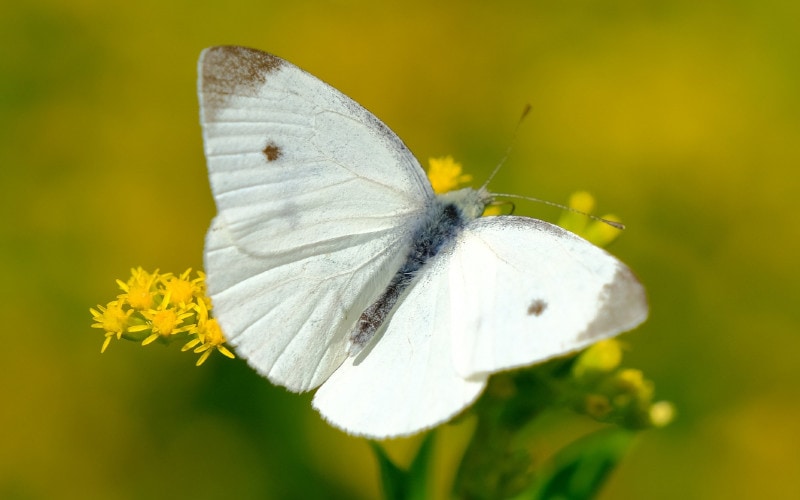
| Scientific Name: | Pieris rapae |
| Wingspan: | 1.75 to 2.25 inches |
| Peak Season: | Spring and fall |
| Adult Lifespan: | Up to 3 weeks |
The cabbage white, as the name suggests, is a whitish or pale yellowish butterfly. A feature that makes it distinct from other Pieridae butterfly species is the black patch on the upper side of the forewing. While males have only one patch, females have two. Both males and females have evenly white with yellowish tint undersides.
Cabbage whites are small to medium-sized with a wingspan of only 1.75 to 2.25 inches. They appear even smaller when they rest with their wings closed. The butterflies have two to three generations yearly and live for three to six weeks.
Preferred Habitat
Cabbage white butterflies love a wide array of flower nectar. Their favorites include red clover, mustards, mints, dandelions, and asters. You can find these butterflies in almost any open landscape, including roadsides, gardens, weedy areas, and even open sites in cities and suburbs.
4. Gray Hairstreak

| Scientific Name: | Strymon melinus |
| Wingspan: | 1 to 1.5 inches |
| Peak Season: | February to November |
| Adult Lifespan: | 3 to 4 weeks |
The gray hairstreak is one of the easiest-to-identify butterflies in Maryland. It is also one of the most common in the state and North America as a whole. Among the most outstanding characteristics of this butterfly species is its false head pattern. Predators often attack the set of false antennae on the hind wings, mistaking them for the head of the insect.
Gray hairstreak adult butterflies have ash-gray forewings featuring huge red spots near the tips. The hind wings have a darker hue, a relatively straight white postmedian line, and an orange border. At the end of each hind wing is a small protrusion that resembles an antenna.
Preferred Habitat
Gray hairstreaks love feeding on nectar from minty flower species, sweet white clovers, milkweed, winter cress, and goldenrod. You can find them in open fields lacking dense vegetation. They are also fond of weedy areas and disturbed lands within residential settings.
5. Northern Metalmark

| Scientific Name: | Calephelis Borealis |
| Wingspan: | 1.15 to 1.25 inches |
| Peak Season: | Mid-June to late July |
| Adult Lifespan: | up to 2 ½ weeks |
Northern metalmarks are common in Maryland, although you will only find them in small, isolated populations. These are small to medium-sized butterflies with a moth-like appearance. The species in North America only boasts of subtle beauty and have dark wings with silver or rust-hued patterns. However, northern metalmarks around the tropics have more spectacular aesthetics.
Preferred Habitat
The northern metalmark butterflies are very particular when picking their habitats. They have a liking for open woodland streams located close to limestone barrens, shale, or serpentine. Adults feed on nectar from flowers like goldenrod, yarrow, ox-eye daisy, white sweet clover, butterfly weed, and sneezeweed.
6. American Copper

| Scientific Name: | Lycaena phlaea |
| Wingspan: | 1 to 1.25 inches |
| Peak Season: | Summer |
| Adult Lifespan: | up to 2 weeks |
Another common butterfly species in Maryland is the American copper. While its forewings are vibrant reddish orange (copper) with dark brown spots and a dark hue along the edges, the hindwings are grayish-brown with a bright orange border.
From the underside, the forewings are gray with black spots, while the hindwings are gray with a jagged copper band along the edge. Generally, the underside has a duller tone.
Preferred Habitat
American coppers love nectar from the goldenrod, butterfly weed, white clover, yarrow, and buttercup. These butterflies are active in the summer, and you can spot them hovering around fields, roadsides, yards, landfills, and grassy areas during bright sunny days. During the peak season, they don’t fly more than two feet above the ground, making them a common sight.
7. Red Admiral
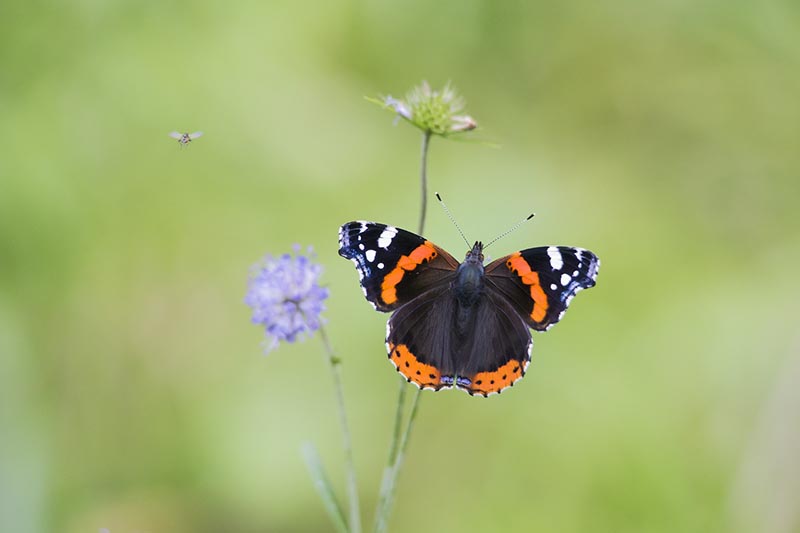
| Scientific Name: | Vanessa atalanta |
| Wingspan: | 1.75 to 2.5 inches |
| Peak Season: | Spring and summer |
| Adult Lifespan: | Up to 10 months |
Maryland is also rich with brushfoot butterflies, one of the most common being the red admiral. These gorgeous creatures with jaw-dropping aesthetics are friendly and don’t mind perching on people’s heads and shoulders. They are a regular garden visitor within residential settings and love basking in sunny spots.
Adult red admirals have striking velvet-black forewings with an orange-red band and white spots at the tip. The hindwings also have a velvety black hue, an orange-red border, and tiny blue eye spots.
Preferred Habitat
Red admirals are not picky in their habitats. You can find them in almost any landscape, from wildflower gardens to disturbed city centers. While they love nectar flowers like milkweed, butterfly bush, asters, daisies, and goldenrod, they can also visit your home garden in search of tree sap, bird droppings, and rotting fruit.
8. Baltimore Checkerspot

| Scientific Name: | Euphydryas phaeton |
| Wingspan: | 1.5 to 2.5 inches |
| Peak Season: | Late spring and early summer |
| Adult Lifespan: | 6 to 9 months |
The Baltimore checkerspot is Maryland’s official state insect. Unfortunately, the butterfly species has become quite rare over the years, making conservation efforts imperative. Looks-wise, the Baltimore checkerspot has black wings with red-orange crescents along the outer margin.
As the name of the butterfly suggests, it has white checker spots right after its black base and orange spots. The white spots are pretty intense against the black and yellow hues, making the Baltimore checkerspot gorgeous.
Preferred Habitat
Baltimore checkerspots rarely visit gardens, making it challenging or impossible to lure them to your backyard. They prefer upland fields or open and sunny wet meadows. Adults love feeding on nectar from wild roses, milkweed, and viburnum.
Final Thoughts
Maryland is rich with a diverse range of butterfly species that differ in size, color, and patterns. You can find these natural beauties gliding across fields, gardens, and woods in the wild and disturbed urban settings. Because butterflies are important pollinators, their presence within the state is a key indicator of environmental health.
We could not list all the butterfly species in Maryland and only focused on the most common ones. Whether you garden for butterflies as a pastime or enjoy butterfly watching in summer, now you have a detailed biological summary of the species you have a greater likelihood of spotting.
Related Read:
Featured Image Credit: soymilk, Pixabay
Contents


